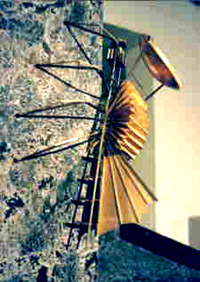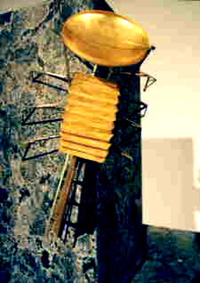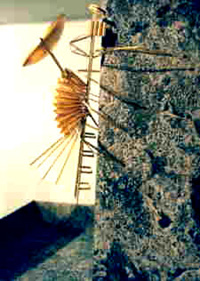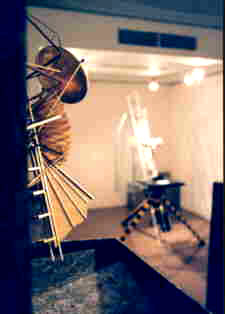Perhaps
the most complex of the Embassies, this apparatus represents the
state of the arts in the aftermath of Walter Benjamin's Age of
mechanical reproduction. As a Parasite, this Embassy makes reference
to the notions of originality and authenticity within a work of
art in the context of global influences and the media. The Parasite
as an insect, animal or plant, has a reserved and special place
in the categorization of all knowledge that began with Diderot
and the Encyclopedists. Not unlike the snake in western civilization,
the parasite bears a moral classification that disqualifies it
as a dignified member of any social group. Social groups being
the sole invention of the human race, this projection and consequent
classification, although not scientific, is nonetheless dominant
in our attitudes towards these life forms. In keeping with the
Embassies mission of exposing the conscious or the subconscious
classification of all things, this Embassy goes beyond Diderot
to explore the relationship between the notions of origin and
authenticity as they are valued in the world of art. That an animal
feeds on another is no more different for an insect or a plant
than it is for a lion or the human race for that matter. The distinction
exists only in its moral context. Therefore, it is the origin
of this moral that we must question. When paralleled, the classification
of florae or fauna and with the division of the disciplines, reveal
the effects of Diderot and the Encyclopedists' in their categorization
of all things. The divisions between Art, Music, Science, Letters,
etc. are clear. Yet, not so clear is the moral value that has
been applied to the separate disciplines and the functional roles
that they have adopted in society. The Parasite as an Embassy
makes reference to the functional alienation of the arts within
society and consequently question the problematic of origin and
its value in the creative process. It is the result of a post
Marchal McLuhan perspective whereby the influences on the creative
process are global timeless. No longer can an artist in Japan
claim to have not been influenced by other cultures or nations,
whether in the present or the past. Furthermore, no longer can
nations claim proprietorship of the creations of contemporary
artists under the guise of national heritage. Here again the question
of originality or the origin of national heritage must resurface,
as it is doubtful whether or not national heritage equals cultural
heritage. Or, for that matter, what is heritage? To explore the
question of heritage, this Embassy reexamines the origins of national
heritage beginning with the anthropological studies of Claud Levi-Straus.
In his research on ancient cultures Levi-Straus made use of art
objects to study ancient societies, thereby enabling him to categorize
cultural groups. The result of this was a wealth of scientific
information. The effect this had was to send nations on a rush
to claim proprietorship of all national heritage's, in fact an
invention of the same, as nations themselves have only existed
for no more than two hundred years. Inevitably these claims are
linked to land or property as it exists today, therefore short
of political influences, this heritage is in large a constantly
growing invention, accrued as new discoveries are made.








